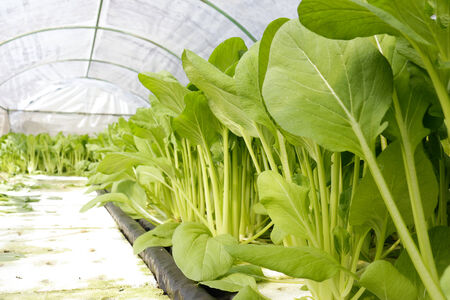Introduction: Why Try Mediterranean and Exotic Crops in the UK?
In recent years, there has been a noticeable shift in the British gardening scene. More and more gardeners up and down the country are rolling up their sleeves and turning to Mediterranean and even tropical crops—plants once thought to be far too tender for our famously unpredictable weather. It’s not just a passing fancy; it’s a response to curiosity, changing tastes, and perhaps even a touch of nostalgia from holidays abroad. The appeal is easy to understand: who wouldn’t want to pluck their own sun-warmed tomatoes, fragrant basil, or even ripe figs straight from the vine here on home soil? Polytunnels have opened new doors, allowing us to stretch the limits of what we can grow beyond the usual apples and cabbages. Of course, these adventures come with their own set of trials. Our climate—blustery winds, damp spells, cool nights—can be unforgiving to plants accustomed to Mediterranean sunshine or tropical humidity. Still, with some care, local know-how, and a willingness to experiment, British gardeners are proving that it’s entirely possible to cultivate these exotic delights right here at home.
2. Setting Up Your Polytunnel for Success
When it comes to growing Mediterranean and exotic crops under the unpredictable British sky, setting up your polytunnel properly is half the battle won. Over the years, Ive learned that a bit of thoughtful planning goes a long way toward transforming your polytunnel into a thriving little oasis.
Choosing the Right Polytunnel
First things first: size matters, but so does quality. While it’s tempting to go for the biggest you can squeeze in, always check your available space and opt for sturdy frames and thick polythene that can withstand our notorious British weather. Don’t scrimp on UV-stabilised covers; cheap plastic will cloud over in no time and leave your tomatoes sulking.
| Feature | Why It Matters |
|---|---|
| Frame Material | Galvanised steel lasts longer against rust and wind than cheaper aluminium or plastic frames. |
| Polythene Thickness | 180-200 microns offers a good balance between insulation and durability. |
| Ventilation Options | Zipped doors and side vents keep air flowing, crucial for preventing fungal problems. |
Placing Your Polytunnel: Sunlight and Shelter
In the UK, squeezing every drop of sunlight is essential. Place your polytunnel where it gets the maximum sun—ideally south-facing, away from tall fences or trees that cast shade. But don’t forget about wind! Our gales can be merciless. Site your tunnel with its shortest end facing prevailing winds to reduce buffeting, and if possible, use hedges or fences as natural windbreaks (but not so close they cause shade).
Orientation Tips
- North-South alignment: Best for even light distribution.
- Sheltered spot: Reduces heat loss and wear on the cover.
- Avoid frost pockets: Low-lying ground can lead to cold snaps inside.
Preparing the Ground
Before you even think about planting your aubergines or citrus saplings, invest time in preparing the soil. Remove weeds thoroughly (they love tunnels too), dig in plenty of organic matter like well-rotted manure or compost, and check drainage—Mediterranean crops hate having their feet wet. If you’re on clay, consider raising beds inside for better drainage and warmth.
A Practical Checklist from Experience
- Double-check measurements before ordering—polytunnels often look smaller when set up!
- Bury edges of the polythene at least 30cm deep to stop wind lifting it off mid-storm.
- Add water butts to collect rainwater from gutters—you’ll need it during summer dry spells.
- Laying down a weed membrane along paths saves hours of backache later on.
The Long View
A well-sited and prepared polytunnel is more than just shelter—it becomes the warm heart of your garden where Mediterranean dreams can flourish despite drizzle, chill, or blustery days. Take your time with these early steps; it’s worth every cup of tea enjoyed among ripening figs later in the season.

3. Top Mediterranean and Exotic Crops to Try
When it comes to polytunnel gardening in Britain, the real joy lies in experimenting with crops that would normally be out of reach for our rather unpredictable climate. Over the years, I’ve found a handful of Mediterranean and exotic favourites that not only survive but truly thrive under the protection of polythene. Tomatoes are perhaps the most rewarding—varieties like Sungold and Gardener’s Delight seem almost made for our conditions, delivering sweet fruits even when summer is less than sizzling. Aubergines (or eggplants, as our American friends would say) can be a bit fussy, but ‘Black Beauty’ and ‘Moneymaker’ have earned their keep with glossy harvests year after year.
Pepper plants, particularly the likes of California Wonder, have adapted well to tunnel life, producing crisp, flavourful pods that taste nothing like their supermarket cousins. Chillies are another polytunnel gem; from the mild ‘Padron’ to fiery ‘Apache’, they add a touch of heat and drama to your growing space. Figs might sound ambitious for these shores, but varieties such as ‘Brown Turkey’ surprise many by fruiting reliably against a warm polytunnel wall—just don’t forget to restrict their roots for best results. And yes, even the odd melon can work wonders: ‘Emir’ is a stalwart performer if you fancy something truly exotic.
Of course, not every attempt has been a roaring success. I once tried my hand at okra—let’s just say it sulked from start to finish and left me with more leaves than pods. Likewise, an overambitious stab at watermelons ended with little more than a handful of golf ball-sized fruits and a lesson in humility. Still, part of the pleasure is in these small adventures and learning what works on our green and pleasant land. Every season brings its share of surprises—and stories worth sharing over a cuppa.
4. Caring for Uncommon Crops the British Way
Looking after Mediterranean and exotic crops in a British polytunnel is a bit like making a good cup of tea: it takes patience, the right touch, and a dash of common sense. Our climate may not be quite Italy or Spain, but with a bit of British ingenuity, we can coax olives, figs, and aubergines to thrive under polythene. Let’s talk through watering, feeding, pruning, and pest control—the cornerstones of crop care—using methods that fit our weather, wallets, and wisdom handed down from keen gardeners.
Watering: Neither Flood nor Drought
Our weather likes to keep us guessing—one week it’s drizzle, the next it’s bone dry. Mediterranean crops dislike ‘wet feet’ but won’t stand drought either. The trick is to water deeply but less often, letting roots reach down rather than stay near the surface. Early morning is best: it mimics dew and avoids midday leaf scorch. Mulch with old newspapers or garden compost helps retain moisture and keeps weeds at bay—a tip from my granddad’s allotment days.
| Crop | Watering Frequency | Special Tips |
|---|---|---|
| Tomatoes | Twice a week (more in heatwaves) | Water at soil level; avoid leaves |
| Aubergines | Every 3-4 days | Add mulch; don’t let roots dry out |
| Lemons/Limes | Once a week (let topsoil dry) | Use rainwater if possible |
| Figs | Weekly (increase as fruit swells) | Don’t overwater; figs hate soggy roots |
Feeding: Frugal Yet Fruitful
Feeding exotics needn’t break the bank. Homemade compost tea or diluted liquid seaweed gives most crops what they need—richness without fuss. For heavy feeders like aubergines and chillies, a fortnightly boost during flowering and fruiting works wonders. Don’t overdo chemical feeds; moderation is key for flavourful harvests and healthy soil life.
DIY Feed Mix for Polytunnel Crops:
- One part well-rotted manure or homemade compost per plant every spring.
- A splash of comfrey tea or nettle brew once a month through summer.
- A handful of wood ash for potassium-hungry crops like tomatoes.
Pruning: Less Is More (But Don’t Skip It)
Brittle stems and leggy growth are all too common in our low-light months. Prune to open up the canopy so air circulates—this wards off mould and allows sunlight to ripen fruit. Pinch out side shoots on tomatoes; trim back rampant vines on melons and cucumbers before they crowd their neighbours. With figs and citrus, remove crossing branches and deadwood each winter—it’s an old habit that pays off come harvest time.
Pest Battles: Vigilance over Chemicals
The British way is watchfulness—little and often checks win the day over blitzing with sprays. Aphids love a warm polytunnel, so introduce ladybirds or brush them off with soapy water. Slugs? A ring of crushed eggshells or a late-night patrol with a torch will do the trick. When red spider mites turn up in hot spells, raise humidity by splashing paths with water—a simple fix passed down from greenhouse veterans.
Common Pests & Practical Solutions Table:
| Pest | Solution |
|---|---|
| Aphids | Ladybirds/soapy water spray |
| Slugs & Snails | Crushed eggshell barriers; hand-picking at dusk |
| Red Spider Mite | Mist paths; increase ventilation |
| Whitefly | Sticky traps; encourage hoverflies by planting marigolds nearby |
If there’s one thing years under canvas have taught me, it’s this: Mediterranean crops reward steady care—not heroic effort. Stick to simple routines, listen to your plants, and use what’s to hand. That’s the British way—making do, muddling through, and enjoying every unexpected lemon or fig come autumn.
5. Dealing with Challenges: Heat, Humidity, and Pests
If you’ve ever tried to grow Mediterranean or exotic crops in a British polytunnel, you’ll know the weather can be as unpredictable as a British queue—sometimes orderly, often full of surprises. One week you’re basking in glorious sunshine, the next you’re hunting for your wellies. Managing heat spikes, grey days, and uninvited guests like slugs is all part and parcel of the adventure.
Managing Heat Spikes
On those rare but cherished hot days when the mercury soars, even a seasoned tomato plant can start to wilt. The trick is ventilation—open up both ends of your polytunnel and prop the doors with a bit of old broomstick if you must. Many an allotment holder swears by shading paint or a layer of horticultural fleece thrown over sensitive crops during midday. Don’t forget to water early in the morning or late evening; plants drink best when the sun’s not glaring down.
Coping with Grey Days and Dampness
Of course, more often than not, we’re contending with persistent cloud cover and that trademark British damp. Humidity can encourage fungal diseases—blight being every tomato grower’s nightmare. A good airflow is your first defence; position your crops so air can circulate freely and consider a small fan if things get really muggy. Old hands will tell you never to water foliage in the evening—keep it to the roots to avoid mildew.
Uninvited Guests: Slugs and Other Pests
Polytunnels might keep out most of the rain, but slugs seem to find their way in regardless. A sprinkle of crushed eggshells around tender seedlings works wonders, as does a ring of copper tape for those particularly prized aubergines. For aphids or whitefly, try companion planting—basil near tomatoes is a classic pairing passed down through generations—or whip up a gentle soap spray to keep numbers down. Whatever you do, avoid harsh chemicals; after all, what’s the point of growing your own if it isn’t wholesome?
Tried-and-True Wisdom from Allotments
Many solutions are handed down over cups of tea on chilly mornings: use netting scavenged from fruit crates to cover seedlings, save spent coffee grounds to deter pests, and always check under leaves for trouble brewing. In my experience, resilience and ingenuity—plus a dash of neighbourly advice—are your best tools for keeping crops happy through whatever the British summer throws at you.
6. Harvesting, Preserving, and Enjoying the Fruits of Your Labour
If you’ve tended your polytunnel through all seasons—nurturing aubergines, figs, chillies, or even the odd melon—you’ll know there’s nothing quite like the anticipation of harvest time. Knowing when to pick is half the battle: tomatoes are best plucked once fully coloured but still firm; peppers should feel glossy and weighty in the hand; and grapes give off that unmistakable aroma when perfectly ripe. In the unpredictable British climate, a careful daily wander through the tunnel ensures you catch fruits at their peak before a sudden cold snap sneaks in.
Preserving your bounty needn’t be a faff. For busy British households, quick methods reign supreme. Roasting Mediterranean veg like courgettes and peppers with olive oil and then storing them in jars stretches summer into winter. Freezing diced aubergine or blanched beans saves both time and space—a tip passed down from many an allotment elder. Drying figs or chillies on a sunny windowsill (or using a low oven) works wonders too, giving you handy bursts of flavour for months to come.
As for enjoying your harvest, why not bridge classic British comfort with a taste of the Med? Try folding your sun-dried tomatoes into a traditional cottage pie for a surprising tang, or add roasted peppers to bubble and squeak for a colourful twist. Nothing beats thick slices of homegrown bread topped with your own basil pesto and grilled aubergine—just the thing with a pot of tea after a day in the garden. And if you fancy something lighter, whip up a zesty Greek salad using your tunnel-grown cucumbers and tomatoes—the perfect nod to both Blighty’s heartiness and southern sunshine.
Don’t forget: sharing your surplus is as much part of the tradition as growing itself. Pass round jars of chutney or bundles of herbs to neighbours and family—it’s good manners and good community spirit, something we Brits have always prided ourselves on.
7. Reflecting on the Journey: Lessons Learned and Looking Ahead
Looking back over this past season in the polytunnel, nurturing Mediterranean and exotic crops right here in the UK has been a true adventure. At first, I wasn’t entirely sure if aubergines, figs, or even a lemon tree would thrive under our often grey skies, but with a bit of perseverance and plenty of cups of tea during those colder mornings, it’s been nothing short of rewarding. Each plant taught me something new—whether it was the patience required for citrus to set fruit or the importance of regular ventilation to keep pesky blight at bay.
The most unexpected delight has been the joy of sharing. When the tomatoes ripened faster than we could eat them, and when chillies hung like red lanterns begging to be picked, there was more than enough to go round. Dropping off a bowl of fresh peppers at Mrs Patel’s door or swapping homegrown courgettes for Alan’s runner beans has brought a lovely sense of community—reminding me that gardening is as much about people as it is about plants.
If you’re thinking about trying your hand at something out of the ordinary next season, I wholeheartedly encourage you to give it a go. Even if you only manage a handful of olives or a few pomegranates, the satisfaction is immense. There will be setbacks, yes, but there’ll also be small triumphs—a flower setting fruit for the first time or the taste of sun-warmed produce you grew yourself. It’s these moments that make all the effort worthwhile.
As we look ahead to next year’s growing calendar, perhaps try one new crop alongside your usual favourites. Embrace the learning curve and don’t be afraid to ask around—chances are someone on your street has tried it before and will have a tip or two to share over the garden fence. After all, in British gardening tradition, there’s always room for another experiment and another story to tell come harvest time.

